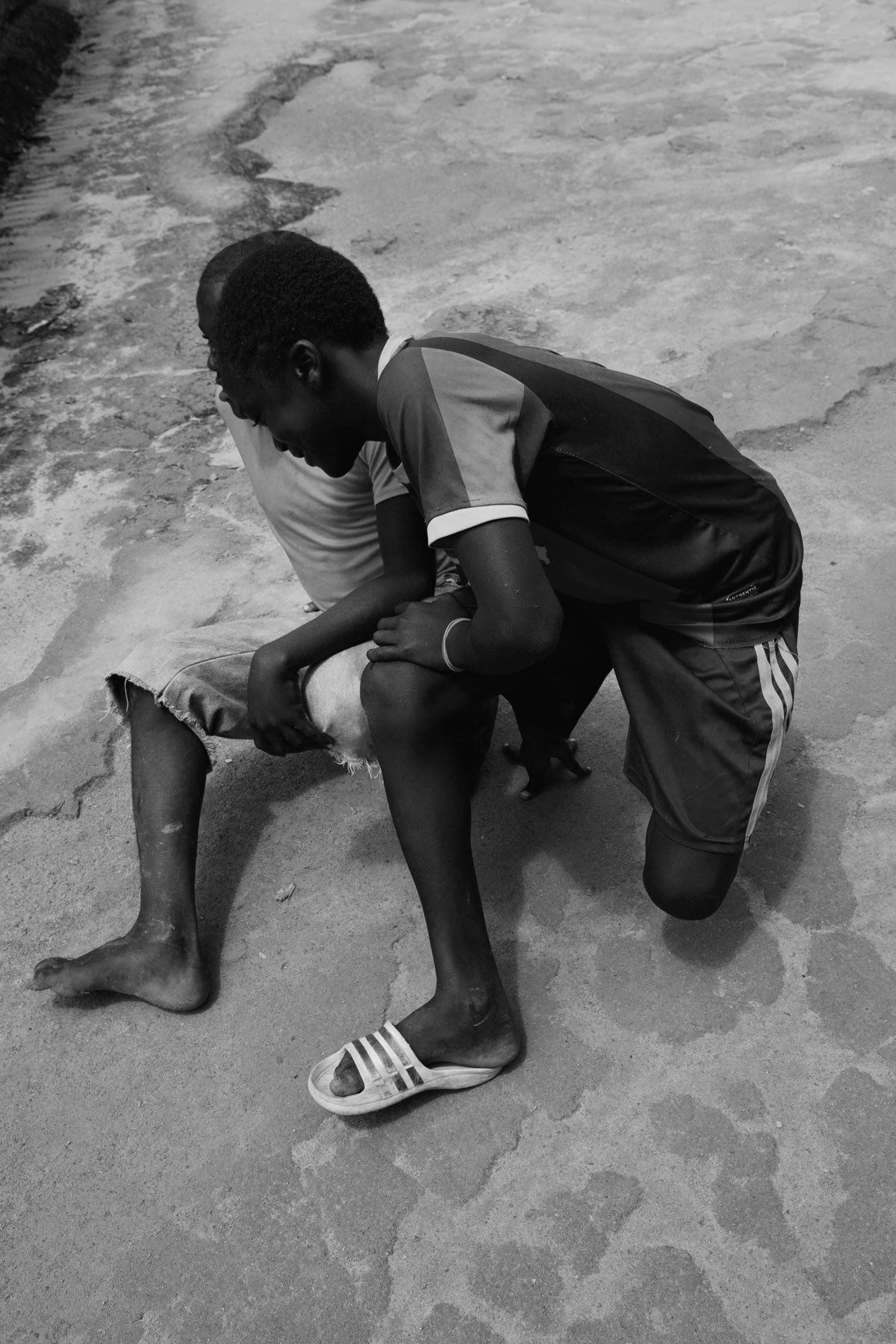Dutch photographer Vivian Sassen’s new exhibition at the ICA, documenting the inhabitants and landscapes of the Surinamese village of Pikin Slee, is a departure from her normal work. Viviane, who grew up in Kenya, is famed for her magnificent use of color and her ability to turn the everyday frame of the body into something otherworldly, caught in hypnotic motion. But this latest series, forming a thematic if not stylistic relation to her photo books Flamboya and Parasomnia, in it’s document of tribal and indigenous societies reduces the natural splendor she found in the jungle into a series of abstract black and white shapes. The Maroons of Suriname are a particularly interesting subject, the descendants of escaped slaves, who made there homes in the rain forests, forming isolated colonies, separate from the indigenous and colonial populations. This isolation was one of the hardest things for Viviane to overcome — Pikin Slee is a three day canoe journey from anywhere, with no roads, infrastructure, electricity or cars.
Viviane’s photography darts between documentary and fashion, quiet and noise, color and simplicity, and these contradictions are still there in her work for Pikin Slee. “Hopefully,” she explains, “some people will look at my images and see themselves; the image bouncing back as a mirror.”

What first brought you to Pikin Slee?
Since Suriname is a former colony of the Netherlands there is a large Surinamese community in the Netherlands. I’ve always been curious to visit the country and experience its culture. Some friends of mine own a house in Suriname, so we traveled there for the first time as tourists. Another friend told me about Pikin Slee; he had been involved in a cultural project in the village.
What attracted you to start shooting its inhabitants and environments?
From the very first moment I set foot on the village grounds I was intrigued by its beauty; the overwhelming nature and the interesting culture. The village is very secluded from the outside world. You can only get there by canoe, a journey of about three hours on the river. There are no roads, no cars, no internet. No running water, and there’s electricity for just three hours in the evening. Somehow, it reminded me of my youth in Kenya back in the early 70s, as we lived in similar circumstances.
What was the actual process of shooting there like?
There’s a group of five Rastafarians who live there, who are artists, they’re woodcarvers and make amazing sculptures and furniture. They play a very significant role in the village, and they helped me with the project. First of all, I asked the Head Captain permission to do the project. Once he agreed, it was all OK, and each day, one of the Rastafarians would accompany me out shooting.
Why did you decide to shot predominantly in black and white, your work is well known for its use of color.
I was longing for a simpler way of looking at the world around me. More silent. It was almost as to reset the eye. To find beauty and meaning in the detail, the everyday. I tried to make sculptures out of ordinary objects, creating a kind of order in chaos, and the black and white helped me do that.

Suriname used to be a Dutch colony, did you sense any relationship between the people of Pikin Slee and the Netherlands?
The founders of the village Pikin Slee call themselves the Maroon. They were former slaves who worked on the Dutch plantations and who escaped from slavery and fled into the jungle, building settlements. That’s how Pikin Slee was founded. I’m still totally blown away by the fact that I could actually speak Dutch in the middle of the South American jungle, with people of African decent. That’s what history does… and it’s crazy!
Were there many influences or references to draw on when you were shooting?
I was not so much influenced by other documents of tribal societies and isolated cultures, I always try to work from the heart; not the head. I am very intuitive and that’s how I work, trying to look at the world around me with a clear and open vision; almost as a child. So although I am aware of all these things, I try not to be biased or bound by any political or cultural prejudice.
You’ve spoken of you’re search for a “simpler kind of photography” in this work, do you think you achieved this?
For me personally, this was a way to go “back to basics”, so to speak, to reset both the eye and the mind, and although there is a very strong formal approach to the things I photographed, I also tried to give them some sort of a soul. The Animist aspect is very strong in both this culture, as in a lot of other cultures I’ve come across. I’m very much drawn to Animism, the mythology of cultures, and how these draw lines between the physical and spiritual.
You’ve also often spoken of you childhood in Africa, do you see a similar post-colonial narrative to your work in Suriname? Or is this too reductive and political a reading of the work?
My work is often misunderstood. Many people have very strong pre-conceived ideas about other cultures, still lead with either paternalism, shame, ignorance or xenophobia. Hopefully, some people will look at my images and see themselves; the image bouncing back as a mirror.

Credits
Text Felix Petty
Photography © Viviane Sassen
